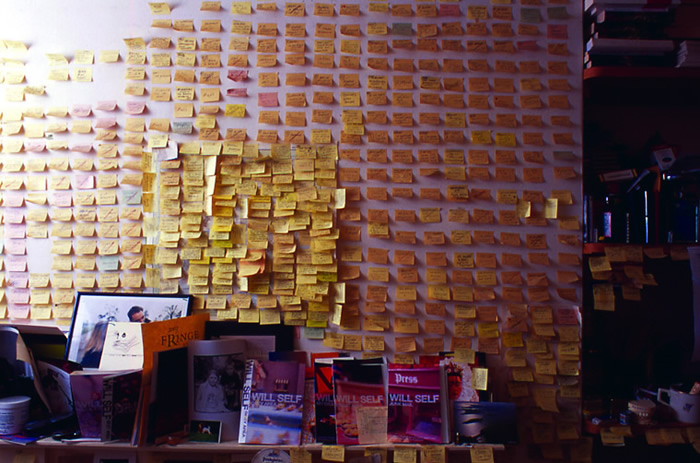Dubai, 1.30am. I totter, unsteady as a newborn foal, along the gantry from the Emirates Airbus that drove me here. In the curvilinear spaces, the potted palms and the glass booths full of cigarette smoke I see this: the topological analogue of international jet travel. Here, time, which has been smeared across the heavens, is once more balled up into the simulacrum of place. I note this: the trail, waymarked by cairns of Johnnie Walker Black Label and Dior Addict,which S-bends its way through the duty free, has been designed purposively so that at any point during his journey, the passenger in transit will be able to view the greatest possible amount of merchandise.
In the American criminal justice system, when the notorious accused is led, handcuffed and shackled, before the eyes and camera lenses of the press pack, this is described as “the perp walk” – perp being short for “perpetrator”. It occurs to me, as I stare out over the peaks and valleys of serried giant Toblerone bars, that this is the purch walk, where purch is an abbreviation of “purchaser”.
What to do? What to do? Being a transit passenger skyside in a major international airport in the dead, jet-howling middle of the night is surely the purest possible mode of the modern human condition – and the powers that be in Dubai seem alive to this, for as I slump up an escalator I notice an advertisement for the shopping centre at Burj Khalifa, the tallest building in the world. Its slug line reads: “The Centre of Now”. I stare at it, thrilled by the audacity of the copywriter; to propose the slave-built city of timesharers as the centre of the world is one thing, but to conceive of it as a sort of zeitgeisty black hole, into which the future and the past alike ceaselessly gurgle, requires true vision. This is how commoditisation looks sub specie aeternitatis.
So, I buy some painkillers – a kind of Panadol that will, the pharmacist assures me, knock me out cold on my next flight to London – and head for McDonald’s. To eat McDonald’s skyside of an international airport in the middle of the night is to take the true Communion of our contemporary Church – for do we not fervently believe that as we place the meaty wafer on our tongue, it dissolves into the body of branding? By which I mean that the standardisation of products throughout the world is our version of transcendence: the McDonald’s cheeseburger we paid for may have disappeared, leaving behind a few ketchup smears and a roundel of dill pickle, but the real McDonald’s cheeseburger remains for ever immanent. Looking about me at my fellow human flotsam, all of whom seem to be eating their food with the same guilty spasms as I just did, I am forced to concur: this is indeed the centre of now.
In March 2008, I flew to Dubai from London and walked for two days across this great city of unbecoming. The building sites lay idle. Dusty Baluchis, Afghans and Somalis sat about in the shade; deprived of passports or the wherewithal for a plane ticket, they were, in effect, prisoners in a penal colony equipped with extensive shopping facilities. I spoke to men who cried as they told me that they hadn’t seen their families in years, nor did they expect to for years to come. In retrospect, I wish I’d been able to tell them they were at the centre of now. Instead, I headed out into the desert, navigating with a compass and following a sight line because there were no maps available with the right human scale, and eventually reached Bab al-Shams, a resort hotel where orientation was lain on in the form of a metal roundel screwed into the bedside table indicating the direction in which Mecca lay.
But that was the periphery of then – this, as I believe I’ve already had cause to remark, is the centre of . . . now. And just as time solidifies in these non-places (as Marc Augé typifies them), so it also becomes diffuse – a will-o’-the-wisp. Under such conditions I find it doesn’t matter how many announcements the airport staff make, or how many bits of paper I’m given with departure time and gate printed on them; I still always manage to be the last one to buckle up.
The first officer proudly informs us that there are 18 flight crew members on board this morning and they speak 18 languages. However, he doesn’t clarify this statement, and as the Airbus – which is as long as a cathedral nave – makes its pilgrimage along the runway, I find myself wondering if there’s one polymath among them and 17 monoglots, or if the distribution of tongues is a little more even. This even though Emirates, displaying a sensitivity to physical location that is remarkable in commercial aviation (the central objective of which is to standardise places as if they were cheeseburgers), has placed cameras on the plane’s wings and tail, so that the passengers can experience take-off visually. Or can we? For in the microseconds it takes for these images to reach the brain, we have moved away from the centre of now. My suspicion is that I’ll never return – at least not in this lifetime.
To read Will’s other New Statesman columns, visit their website here.
